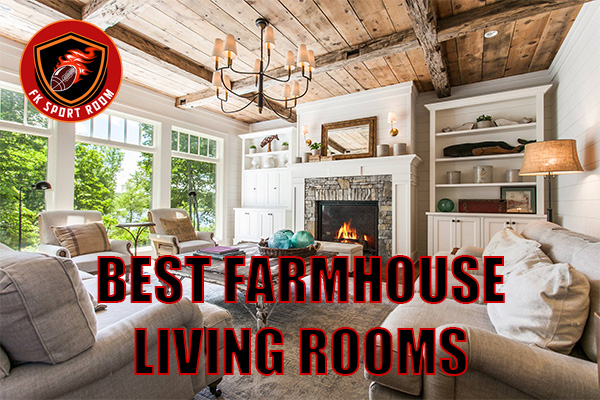Blogs
Best Farmhouse Living Rooms: Design Ideas, Paint Colors, and Styling Tips
Farmhouse living rooms have become one of the most beloved interior design styles for homeowners who crave warmth, charm, and timeless appeal. With a mix of rustic textures, neutral tones, and cozy accents, the best farmhouse living rooms strike the perfect balance between comfort and sophistication. Whether you’re renovating your entire space or simply refreshing your decor, this guide will inspire you with color ideas, styling tips, and practical ways to bring the farmhouse aesthetic to life.
In this blog post, we’ll explore popular farmhouse paint colors, how to pair them with furniture and lighting, and the pros and cons of the farmhouse style. By the end, you’ll be ready to transform your living room into a welcoming haven.

What makes the best farmhouse living rooms?
Farmhouse interiors combine rustic warmth with modern simplicity. They’re not about cluttered country charm but rather about creating an inviting, stylish, and lived-in feel. The best farmhouse living rooms typically include:
- Neutral or nature-inspired paint colors
- Cozy textiles like cotton, linen, or wool
- Wooden accents (beams, coffee tables, shelving)
- Comfortable seating such as oversized sofas or armchairs
- Farmhouse lighting fixtures, like lantern-style pendants or wrought-iron chandeliers
Best paint colors for farmhouse living rooms
Color plays a huge role in achieving the farmhouse look. Below are five timeless paint color ideas, plus tips on how to style each with furniture, lighting, and rugs.
1. Classic white
White walls are the hallmark of farmhouse interiors, offering a crisp and clean backdrop for rustic furniture.
How to style it:
- Furniture: Pair with distressed wooden coffee tables, linen sofas, and open shelving.
- Lighting: Black metal sconces or lantern chandeliers add contrast.
- Rugs: Layer a jute rug with a patterned kilim or striped cotton rug for texture.
Pros: Makes the room feel bright and spacious.
Cons: Can feel too sterile if not balanced with warm textures.
2. Warm beige
Beige brings subtle warmth while maintaining the farmhouse style’s neutral base.
How to style it:
- Furniture: Natural wood tones and tan leather sofas pair beautifully with beige.
- Lighting: Opt for warm Edison bulbs in farmhouse lanterns.
- Rugs: A vintage Persian rug in muted reds and blues creates depth.
Pros: Cozy and versatile.
Cons: Needs layering to avoid looking flat.
3. Soft gray
Gray is perfect for modern farmhouse living rooms, offering sophistication while keeping things neutral.
How to style it:
- Furniture: White slipcovered sofas or gray sectional sofas look chic.
- Lighting: Brushed nickel or industrial-inspired lighting fixtures add balance.
- Rugs: Go for a light patterned rug in gray and cream for harmony.
Pros: Easy to pair with rustic and modern elements.
Cons: Cool grays can feel cold without warm accents.
4. Sage green
For those who want a touch of color, sage green offers a calming, nature-inspired hue.
How to style it:
- Furniture: Pair with wicker chairs, reclaimed wood tables, and off-white slipcovers.
- Lighting: Brass or gold-toned lamps highlight sage beautifully.
- Rugs: A soft wool rug in beige or cream keeps the look grounded.
Pros: Adds personality while staying farmhouse-friendly.
Cons: Can limit furniture color choices if too bold.
5. Soft blue
Blue farmhouse living rooms feel refreshing and cozy at the same time.
How to style it:
- Furniture: Whitewashed wood and neutral-toned sofas complement blue walls.
- Lighting: Choose coastal-inspired fixtures, such as woven pendants.
- Rugs: A striped navy-and-cream rug ties the look together.
Pros: Calming and family-friendly.
Cons: Can feel less traditional farmhouse if overdone.
Key elements of farmhouse furniture
Once you’ve chosen your paint color, the furniture ties everything together. Here are must-have farmhouse pieces:
- Sofas: Oversized, slipcovered, or tufted in neutral fabrics.
- Coffee tables: Reclaimed wood or white-painted bases with natural tops.
- Accent chairs: Wingback, rocking, or rustic wooden chairs.
- Shelving: Open wood shelves with iron brackets.
Tip: Mix old and new. Vintage flea-market finds blend beautifully with modern farmhouse furniture.
Farmhouse lighting ideas
Lighting can make or break your farmhouse aesthetic. Consider these ideas:
- Lantern pendants: Great for high ceilings.
- Wrought-iron chandeliers: Adds drama over a coffee table.
- Wall sconces: Perfect for cozy corners.
- Table lamps: Ceramic or wood bases for a rustic touch.
Always layer lighting for ambiance—combine overhead fixtures with floor or table lamps.
Rugs that define farmhouse style
Rugs are an easy way to add texture and warmth. Top farmhouse rug ideas include:
- Jute rugs: Natural, durable, and earthy.
- Vintage-inspired rugs: Persian or Oriental patterns in muted tones.
- Striped cotton rugs: Casual and charming.
- Layered rugs: Place a patterned rug on top of a larger jute base for depth.
Pros and cons of farmhouse living rooms
Like every design style, farmhouse décor has strengths and challenges.
Pros:
- Warm, inviting, and family-friendly
- Timeless aesthetic that won’t go out of style
- Easy to personalize with vintage finds and DIY projects
- Works in both small and large spaces
Cons:
- Can feel overdone if too many rustic accents are used
- Neutrals may look bland without layered textures
- White walls require frequent cleaning in busy households
Practical tips for styling farmhouse living rooms
- Mix textures: Pair linen sofas with wool throws, leather chairs, and woven baskets.
- Add greenery: Use potted plants or faux eucalyptus stems for a fresh touch.
- Incorporate vintage accents: Old signs, barn doors, or antique mirrors add authenticity.
- Use open storage: Wire baskets and wooden crates keep things organized while stylish.
- Don’t forget comfort: Farmhouse style is about livability, so prioritize cozy seating and soft lighting.
FAQ: Best farmhouse living rooms
1. What is the most relaxing color for a farmhouse living room?
Soft neutrals like beige and sage green are the most relaxing, as they create a warm and calming atmosphere.
2. Can farmhouse living rooms be modern?
Yes! Modern farmhouse combines rustic textures with sleek lines and updated finishes for a fresh take on the style.
3. What kind of flooring works best in farmhouse living rooms?
Hardwood floors—especially in warm oak or distressed finishes—work best. Pair them with layered rugs for comfort.
4. How do I make my farmhouse living room cozy?
Add soft textiles like throw blankets, plush pillows, and area rugs. Use warm lighting and greenery to enhance coziness.
Conclusion
The best farmhouse living rooms blend rustic charm with modern simplicity, creating a space that’s both timeless and comfortable. Whether you go with classic white walls or a soothing sage green, the right paint color paired with farmhouse furniture, layered rugs, and warm lighting will bring your vision to life. Remember, the farmhouse look is about balance—mixing old with new, rustic with refined, and cozy with stylish.
With these tips and ideas, you’re ready to design a living room that feels warm, inviting, and unmistakably farmhouse.
